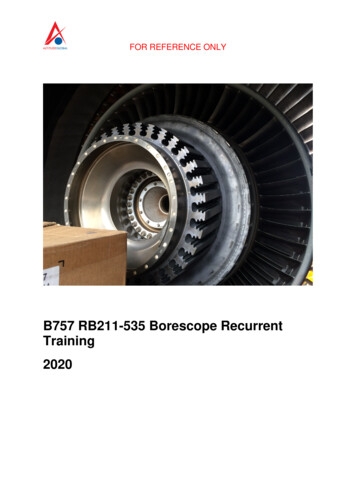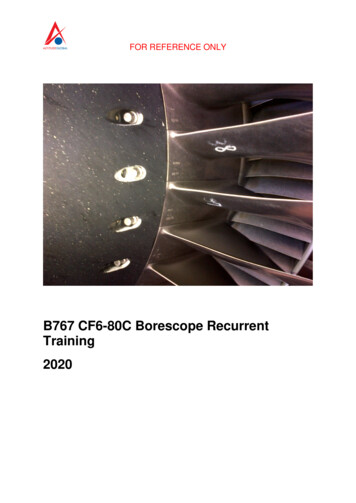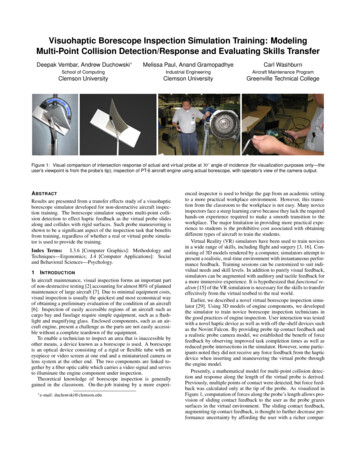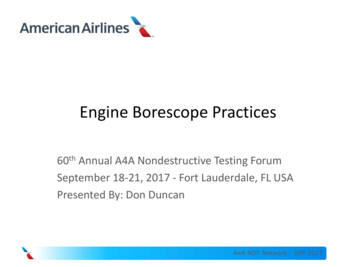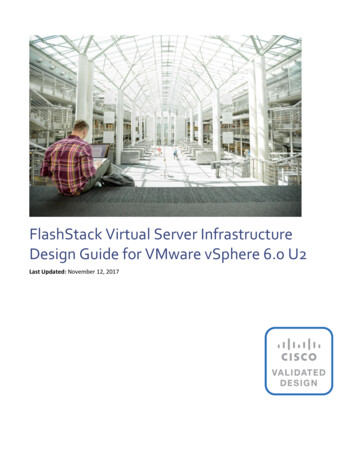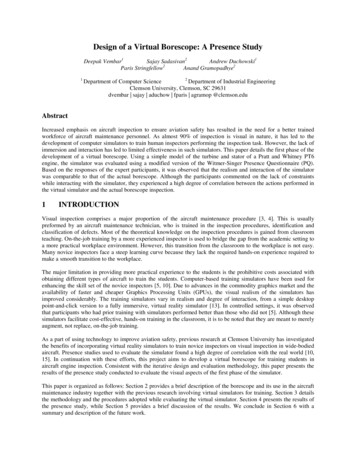
Transcription
Design of a Virtual Borescope: A Presence StudyDeepak Vembar1Sajay Sadasivan2Andrew Duchowski12Paris StringfellowAnand Gramopadhye212Department of Computer ScienceDepartment of Industrial EngineeringClemson University, Clemson, SC 29631dvembar sajay aduchow fparis agramop @clemson.eduAbstractIncreased emphasis on aircraft inspection to ensure aviation safety has resulted in the need for a better trainedworkforce of aircraft maintenance personnel. As almost 90% of inspection is visual in nature, it has led to thedevelopment of computer simulators to train human inspectors performing the inspection task. However, the lack ofimmersion and interaction has led to limited effectiveness in such simulators. This paper details the first phase of thedevelopment of a virtual borescope. Using a simple model of the turbine and stator of a Pratt and Whitney PT6engine, the simulator was evaluated using a modified version of the Witmer-Singer Presence Questionnaire (PQ).Based on the responses of the expert participants, it was observed that the realism and interaction of the simulatorwas comparable to that of the actual borescope. Although the participants commented on the lack of constraintswhile interacting with the simulator, they experienced a high degree of correlation between the actions performed inthe virtual simulator and the actual borescope inspection.1INTRODUCTIONVisual inspection comprises a major proportion of the aircraft maintenance procedure [3, 4]. This is usuallypreformed by an aircraft maintenance technician, who is trained in the inspection procedures, identification andclassification of defects. Most of the theoretical knowledge on the inspection procedures is gained from classroomteaching. On-the-job training by a more experienced inspector is used to bridge the gap from the academic setting toa more practical workplace environment. However, this transition from the classroom to the workplace is not easy.Many novice inspectors face a steep learning curve because they lack the required hands-on experience required tomake a smooth transition to the workplace.The major limitation in providing more practical experience to the students is the prohibitive costs associated withobtaining different types of aircraft to train the students. Computer-based training simulators have been used forenhancing the skill set of the novice inspectors [5, 10]. Due to advances in the commodity graphics market and theavailability of faster and cheaper Graphics Processing Units (GPUs), the visual realism of the simulators hasimproved considerably. The training simulators vary in realism and degree of interaction, from a simple desktoppoint-and-click version to a fully immersive, virtual reality simulator [13]. In controlled settings, it was observedthat participants who had prior training with simulators performed better than those who did not [5]. Although thesesimulators facilitate cost-effective, hands-on training in the classroom, it is to be noted that they are meant to merelyaugment, not replace, on-the-job training.As a part of using technology to improve aviation safety, previous research at Clemson University has investigatedthe benefits of incorporating virtual reality simulators to train novice inspectors on visual inspection in wide-bodiedaircraft. Presence studies used to evaluate the simulator found a high degree of correlation with the real world [10,15]. In continuation with these efforts, this project aims to develop a virtual borescope for training students inaircraft engine inspection. Consistent with the iterative design and evaluation methodology, this paper presents theresults of the presence study conducted to evaluate the visual aspects of the first phase of the simulator.This paper is organized as follows: Section 2 provides a brief description of the borescope and its use in the aircraftmaintenance industry together with the previous research involving virtual simulators for training. Section 3 detailsthe methodology and the procedures adopted while evaluating the virtual simulator. Section 4 presents the results ofthe presence study, while Section 5 provides a brief discussion of the results. We conclude in Section 6 with asummary and description of the future work.
2BACKGROUNDVirtual simulators have been used for training novices in a wide spectrum of areas, ranging from flight training tosurgical simulators [2, 6, 7, 8, 11, 16, 17]. The simulator usually consists of a 3D model rendered on the computerwith which the users can interact in real-time using input devices ranging from a simple joystick to a more expensive6 degree-of-freedom (DOF) mouse. The displays vary from a simple computer monitor to fully immersive headmounted-displays. In this paper, we consider mainly non-immersive training simulators.This section is organized as follows: Section 2.1 describes the borescope and its application in the aircraftmaintenance procedures. Section 2.2 describes some of the previous endeavours undertaken to develop virtualtraining tools similar to the borescope and we conclude in Section 2.3 with an outline of the iterative design processadopted for the development of the virtual simulator.2.1BorescopeThe borescope is a tool used to inspect the internal parts of the engine for defects such as cracks, stress fractures andcorrosion. The most commonly used form of the borescope is the video borescope. Although other forms of theborescope such as the optical borescope, pictured in Figure 1(a), are in use, the video borescope is more advancedand has numerous advantages over the optical borescopes. In this paper, the term borescope is taken to refer to thevideo borescope.The borescope consists of a handheld unit and a long, flexible, fibre-optic cable as shown in Figure 1(b). Thehandheld unit consists of a full color LCD screen and a mini-joystick. The fibre-optic cable is connected to the tip ofthe handheld unit and has a camera and light source at the other end. The joystick controls the articulation of thefibre- optic tip attached to the unit. Buttons on the handheld enable the inspector to take screen captures of theimages on the LCD screen or return the articulating tip to the neutral position before withdrawing the fibre-opticcable from the engine. The inspector can also obtain a closer view of the engine components by using themagnification button on the handheld device.To perform a borescope inspection of the engine, the inspector first inserts the fibre-optic cable through the fuelinjection manifolds on the engine casing. Usually, a special guide tube is used to steer the tip of the borescopethrough the various stages of the turbines and stators and directly to the hot-section of the engine. The borescope isthen manipulated with the help of the joystick and the turbine blades are inspected for defects. The borescopeinspection can either be performed by a single inspector who guides the borescope tip through the engine, or by twopersons. In the latter case, the technician performing the inspection keeps the borescope stationary in a fixed positionin which he has full view of the turbine, while the other person manually rotates the engine shaft, which in turnrotates the turbines. Although this solution is viable in case of small engines, it is not practical in case of widebodied aircraft.a) Optical borescopeb) Video borescope (Courtesy Everest VIT)Figure 1: Optical borescope (left) compared to the video borescope (right)
2.2Past ResearchThe borescope is similar in design to the commonly used medical tools such as the endoscope. Both instruments areused to check for abnormalities by visual inspection. The skills and the hand-eye coordination needed to manipulatethe articulating tip in both these devices are similar in nature. However, there are two major differences between theinstruments. Whereas the endoscope displays the view as seen from the camera on a TV screen, the borescopeprovides the output of the camera on a 3” x 2” LCD panel on the handheld device. The second and more importantdifference is that, unlike the borescope, tissue deformation occurs due to the contact between the walls of theintestine and the endoscope as it is traversing through the human body cavity. For a realistic representation, this hasto be taken into consideration while designing the virtual endoscopy simulator.Past research has led to the development of “desktop VR” simulators for training doctors in bronchoscopy,colonoscopy, etc [2, 6, 14, 15]. Virtual endoscopy consists of navigation of a virtual camera through a 3Dreconstruction of a patient's anatomy enabling the exploration of the internal structures to assist in surgical planning.Virtual exploration through patient-specific data can help the surgeon perform a diagnosis without having to operateon the patient. The data can also be used to train novice doctors in the correct procedures to be adopted forperforming the operation. Virtual endoscopy can be used to screen, diagnose, evaluate and assist determination ofsurgical approach, and provide surveillance of certain malignancies [17].The basic methodologies adopted in developing the various virtual endoscopy medical training simulators for aresimilar. As the first step, high resolution data obtained from CT scans or MRI are used to reconstruct realistic, 3Dmodels of the human anatomy. If needed, the operator can configure the 3D data with texture-mapping to introduceabnormalities such as tumours, lesions and polyps to the 3D models. Physically realistic effects such as soft tissuedeformation and haptics can also be used to increase the sense of realism and presence in the simulator. Evaluationstudies used to assess the realism of such simulators showed that participants felt that the virtual simulators stronglyrepresented the real world environment [5, 17]. The second and most important step is the user interaction in thevirtual model. The participants can either use a “free-fly” model of camera or use a predetermined route to navigatethrough the model. Using a variety of input devices, the users interact with the virtual scene and perform pre-definedtasks which help determine the effectiveness of the simulator. The third step consists of assessing the benefits oftraining with the virtual simulator in the real world scenario. Process and performance measures such as the totaltime taken, tumours identified and missed as well as subjective questionnaires are used to evaluate the simulator.Ferlitsch et.al. observed that novices trained on such simulators performed their tasks faster and with fewer errorsthan those who did not have similar training [5]. They also observed that there are distinct differences between thestrategies adopted by expert doctors and novices when they were asked to use the simulator. It was also found thatusing real life props, such as a mannequin, and providing real time force feedback increased sense of presence andrealism of the virtual simulator [7, 8, 17]. Although repeated training on the simulators have been found to improvethe performance of novices, the transfer effects of training on virtual simulators and performance in the real worldhave not been fully studied. We plan to investigate this aspect of training simulators by developing and evaluatingthe virtual borescope.Evaluation &TestingEvaluation& TestingEvaluation& TestingFeasibility StudyPhase IDevelopment of the DesktopSimulatorPhase IIDevelopment of the hand-helddevice with haptic feedbackPhase IIIFinal prototypeFigure 2: Iterative design methodology with user evaluation at each step
2.3Iterative Design MethodologyThe virtual borescope project seeks to develop a realistic representation of the borescope inspection process fortraining students in adopting correct procedures for aircraft engine inspection. The project has been divided intothree iterative phases as seen from Figure 2. The first phase is a pilot study where the feasibility of developing thevirtual borescope is analyzed with the help of a pilot simulator. This paper describes the expert inspectors’evaluation of the first phase of the simulator. The second phase will lead to the development of a desktop version ofthe virtual simulator with realistic textures for defects and user performance metrics used to evaluate the simulator.The third phase will result in the development of a hand-held device similar to the actual borescope, but with the 3Dmodels on the LCD screen and haptic feedback for a realistic, training experience.3PROCEDURE3.1EquipmentThe experiment was carried out on a Pentium 4, 2.6 GHz computer, with 512 MB of RAM and a GeForce 5700Ultragraphics card. The frame rates were maintained above 30fps for an interactive, real-time experience. An off-theshelf Gravis Eliminator Pro gamepad was used control the camera position and orientation in the simulation. Unlikethe actual borescope where the tip has limited motion, the camera in the virtual borescope had no constraints andcould rotate a full 360 about either axis. The camera orientation was controlled by the analog, 2-axis directional padon the gamepad. Two buttons on the gamepad simulated the feed and withdrawal of the probe by moving the cameraalong the direction of the view vector. The experimental setup is shown in Figure 3(a), with a close-up view of thegamepad in Figure 3(b).3.2SubjectsEight participants (all male) were invited to evaluate the virtual borescope. All the participants were familiar withthe video borescope and had extensive experience using the borescope for aircraft engine inspection. Each of theparticipants was either an aircraft maintenance technician or taught an aircraft maintenance course on engine andaircraft inspection. The participants were asked to interact with the desktop version of the borescope simulator andexpress their observations on the visual realism and correctness of the simulator. Their comments were recorded forlater transcription. On completion of the experiment, the
The virtual borescope project seeks to develop a realistic representation of the borescope inspection process for training students in adopting correct procedures for aircraft engine inspection. The project has been divided into three iterative phases as seen from Figure 2. The first phase is a pilot study where the feasibility of developing the virtual borescope is analyzed with the help of a .
